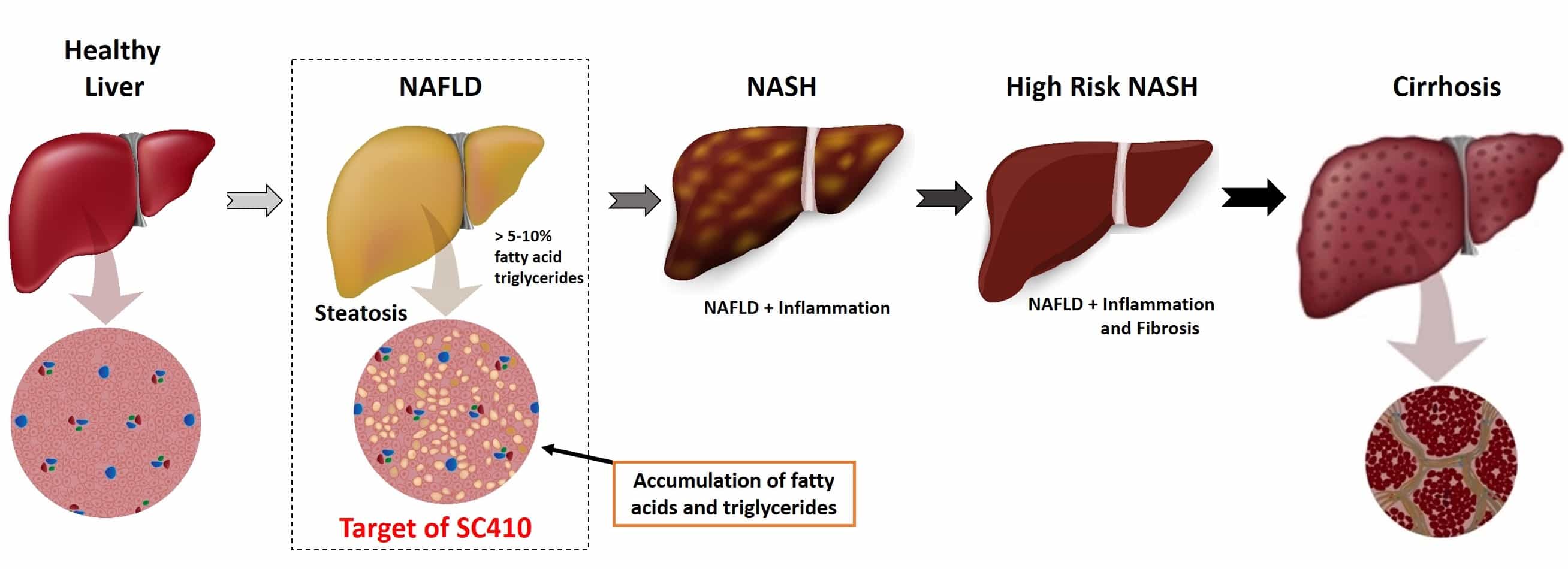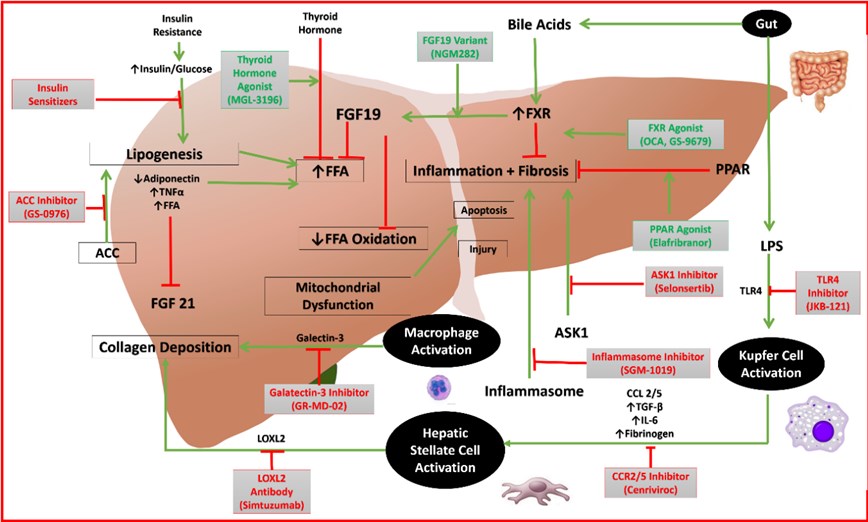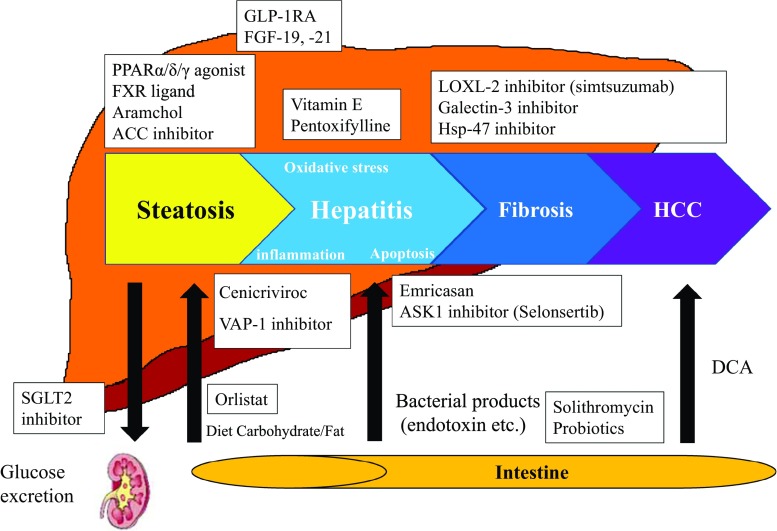NASH Target Development Services for Fibrosis
Fibrosis is a key feature of advanced nonalcoholic steatohepatitis (NASH), which increases the risk of cirrhosis (scarring of the liver) and liver cancer. Recent studies have indicated that correcting the various mechanisms initiating hepatic fibrosis is a potential therapeutic strategy for NASH. Creative Biolabs, as a world-leading service provider for NASH drug discovery, provides global customers with the screening, structural characterization and functional profiling of targets related to the mechanism of liver fibrosis based on our powerful technical platform.
Introduction of Fibrosis in NASH
Persistent hepatocyte injury and inflammatory reaction may lead to the formation of fibrosis during the pathological process of NASH. Liver fibrosis is a very severe feature of NASH, which increases the risk of cirrhosis and liver cancer as well as liver-related morbidity and mortality. Currently, none of therapeutic agents has been developed to reverse the advanced fibrosis in patients with NASH. Although some therapeutic agents targeting various stimuli that initially damage liver cells may prevent the development of NASH and fibrosis, targeting the pathways mediating fibrosis may reverse the progression of liver disease. Interestingly, correcting the underlying fibrogenic stimuli may be a good strategy for cirrhosis reversion.
 Fig.1 The mechanism of fibrosis in NASH.
Fig.1 The mechanism of fibrosis in NASH.
Galectin 3 Inhibitors
Galectin 3, a member of the galectin glycan-binding proteins family, is widely expressed by immune and epithelial cells. It displays different functions according to its cellular location, cell type and mechanism of injury. In vivo and in vitro studies have shown hepatic galectin 3 exerts a pro-fibrogenic effect. This protein can stimulate the proliferation and activation of myofibroblast, HSC and promote hepatic progenitor cell expansion and differentiation. Galectin 3 inhibitors such as GR-MD-02 (galactoarabino-rhamnogalaturonan) or GM-CT-01 (galactomannan) can prevent the development of NASH and fibrosis, even reverse established severe fibrosis and cirrhosis.
Lysyl Oxidase-Like Protein 2 (LOXL2) Inhibitors
Lysyl oxidase-like protein 2 (LOXL2) is a member of the lysyl oxidase (LOX) family that catalyzes the oxidative deamination of the ε-amino group of lysines and hydroxylysines in collagen and elastin to promote the crosslinking of these molecules. During the fibrogenesis, molecule crosslinking is very essential for the tensile strength of the extracellular matrix. LOXL2 has been revealed to promote fibrogenesis in patients with NASH, while its inhibitors may be promising therapeutic agents for NASH-related liver fibrosis.
 Fig.2 Mechanism of action of emerging drugs for NAFLD. (Dibba, 2018)
Fig.2 Mechanism of action of emerging drugs for NAFLD. (Dibba, 2018)
Leukotriene Receptor Antagonists
Leukotrienes are a family of eicosanoid inflammatory mediators that are synthesized in the leucocytes from arachidonic acid (AA) through the actions of 5-lipoxygenase (5-LO). The overexpression of 5-LO is found in experimental models of NASH. It has been reported leukotriene pathway mediates liver inflammation and fibrosis, involved in the progression of NASH. Leukotriene receptor antagonists MN-001 (tipelukast) is a novel small-molecule compound for advanced NASH treatment via inhibiting the actions of 5-LO, leukotriene receptor, phosphodiesterase 3 (PDE3) and PDE4.
Caspase Inhibitors
Caspases are the family of cysteine proteases (cysteine aspartatespecific proteases) that initiate and mediate apoptosis. Increased hepatocyte apoptosis is associated with the progression of NASH and NASH-related cirrhosis. It has been revealed that apoptosis-associated molecular signals and cytokines may trigger liver inflammation, wound healing, and fibrogenesis. Caspase inhibitors may ameliorate necro-inflammation and fibrosis in experimental models of NASH.
Hedgehog (Hh) Pathway Inhibitors
Hedgehog (Hh) pathway plays an important role in the regulation of cell differentiation, proliferation, migration, and apoptosis during fetal development. In the liver, Hh pathway activation promotes proliferation of hepatic progenitor cells and accumulation of inflammatory cells as well as enhances fibrogenesis and vascular remodeling. In animal models of NASH, Hh pathway hyperactivation promotes fibrosis. Hh pathway inhibitors such as vismodegib or cyclopamine have been shown to reverse advanced fibrosis, experimental NASH, and hepatocellular carcinoma.
 Fig.3 Targets of upcoming therapies for NASH/NAFLD. (Sumida, 2018)
Fig.3 Targets of upcoming therapies for NASH/NAFLD. (Sumida, 2018)
Heat Shock Protein 47 (HSP47) Inhibitors
Hsp47 (heat shock protein 47) is a collagen-specific molecular chaperone localized in the endoplasmic reticulum. It is essential for the maturation and secretion of collagen. The increased expression of Hsp47 is associated with collagen-related disorders such as fibrosis. The knockdown of Hsp47 can significantly decrease the accumulation of collagen in fibrotic tissues and prevents the promotion of fibrosis.
CYR61 Analogues
The matricellular protein cysteine-rich protein 61 (CYR61) is a key regulator of myofibroblast senescence and fibrosis resolution in the liver. CYR61 has been indicated to inhibit liver fibrogenesis and promote fibrosis regression by inducing senescence of activated HSCs and portal fibroblasts. Hence, CYR61 analogues could be potential the therapeutic agents for the treatment of NASH-related advanced fibrosis.
Small Molecule Antagonist
Increasing data suggest that some molecules such as tissue growth factor-beta (TGFβ), integrin αvβ6, endothelin-a receptor, cannabinoid receptors, connective tissue growth factor (CTGF), angiotensin-1 receptor, angiotensin converting enzyme (AT1/ACE), growth-related oncogene (Gro)-α, and monocyte chemoattractant protein-1 (MCP-1) are involved in the fibrotic progression. Therefore, antagonists targeting these small molecules may be the attractive strategies for NASH-related advanced fibrosis.
Features
- Excellent technical team who has engaged in the research of NASH therapy for many years
- Powerful technologies which facilitate target screening and identification as well as NASH drug discovery
- One-stop service relieving your scientific research pressure
- Best after-sale service
Creative Biolabs is an undisputed expert in the field of NASH drug discovery. We have served hundreds of customers and received ample praise from all over the world. We not only offer first-in-class target construction and custom target screening services to meet customers’ various requirements but also provide antibody development (e.g. Phage Display & Antibody Library Services, Antibody Analysis Services, Antibody Engineering Services) or the one-stop service of NASH drug discovery. If you are interested in our service lists, please feel free to contact us for more details.
References
- Dibba, P., et al. Emerging therapeutic targets and experimental drugs for the treatment of NAFLD. Diseases. 2018, 6(3): 83.
- Sumida, Y.; Yoneda, M. Current and future pharmacological therapies for NAFLD/NASH. Journal of Gastroenterology. 2018, 53(3): 362-376.
 For Research Use Only.
For Research Use Only.